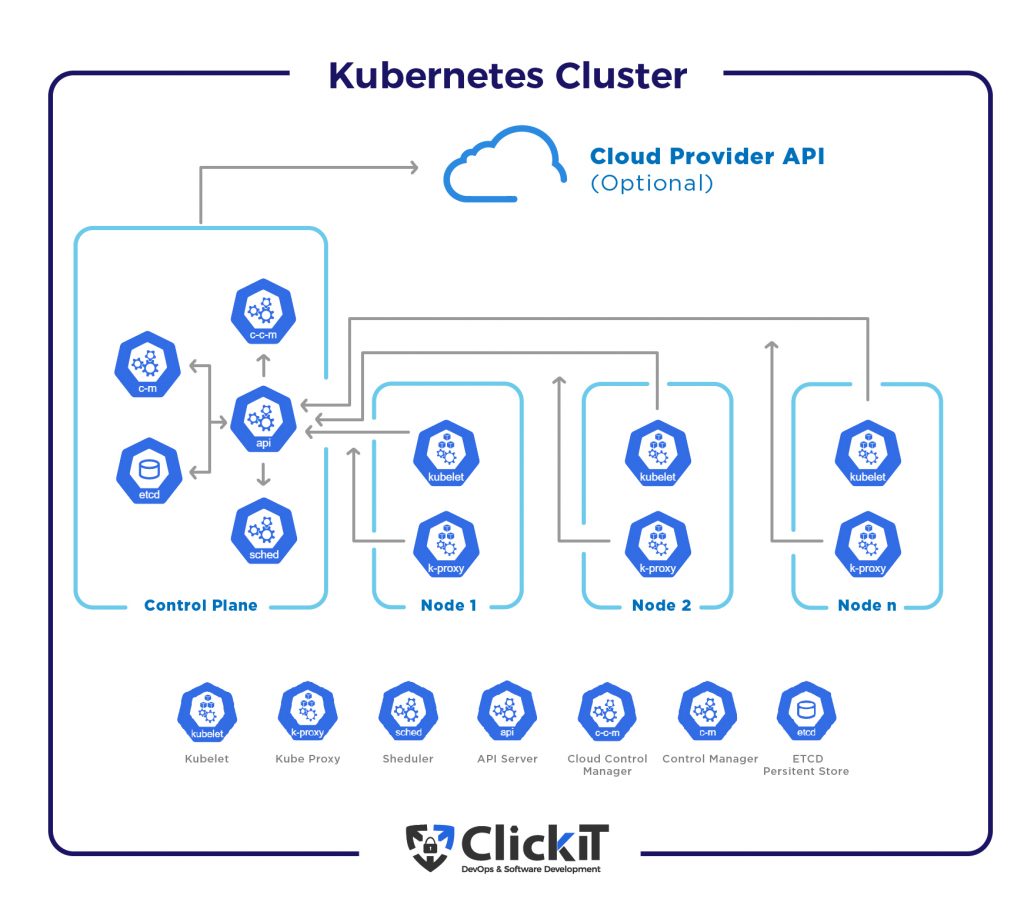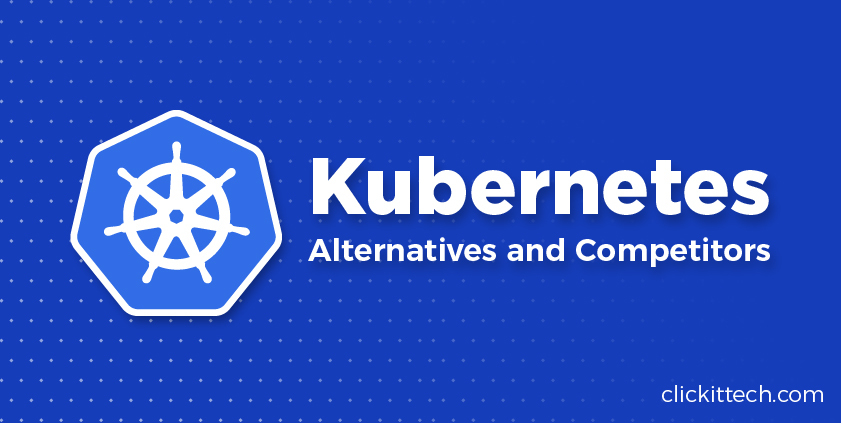Introduction to Kubernetes
Kubernetes is an open-source container orchestration tool developed by Google and is also known as K8s. It is used in managing the complete lifecycle of containerized applications. Kubernetes provides high availability, scalability, and predictability to the containerized application. It automates the deployment, management, and scaling of containerized applications. Kubernetes also supports automated rollout & rollbacks, service discovery, storage orchestration, scaling, batch execution, and a lot more. Kubernetes provides the cluster where containerized applications can be deployed. Kubernetes is not the only container orchestration tool; various Kubernetes Alternatives are available in the market.
Table of contents
- Introduction to Kubernetes
- Orchestration: Why do we need Container Orchestration
- How to choose the best Container Orchestration tool?
- Challenges with using Kubernetes for container orchestration
- Alternatives to Kubernetes
- RedHat OpenShift
- Docker Swarm
- Nomad
- AWS Fargate
- Comparison Table of Kubernetes alternatives
- How to migrate from Kubernetes to Amazon ECS
- Micro-service using the alternatives of Kubernetes- Docker Swarm
- Use Cases of Kubernetes Alternatives
- Conclusion
- FAQs
Before we talk about the Kubernetes competitors, let’s explore the key components of Kubernetes. The Kubernetes cluster consists of at least one worker node where containerized applications are deployed and one master node or control plane which manages the worker nodes. The Control plane or master node consists of Kube-API server, etcd, Kube-scheduler, and Kube-controller-manager, whereas the worker node consists of Kubelet, Kube-Proxy, and Container Runtime.
You can also find this blog on our DZone profile

Orchestration: Why do we need Container Orchestration?
We know that Kubernetes is used for container orchestration. Now let’s examine what orchestration really means and why we need it, before exploring different Kubernetes alternatives available in the market.
Orchestration is a way of automating the operational efforts required for managing containerized applications. It is a process that automates applications’ scale-in, scale-out, networking, deployments of containers, etc. All of these operations mentioned above can also be done without an orchestrator if the containerized application to be managed is very small. But when it comes to microservices applications with hundreds of microservices running thousands of containers, it becomes challenging to manage all these containers, and here comes an Orchestrator to rescue.
Kubernetes is not the only player in the market, different Kubernetes competitors and Kubernetes alternatives like Amazon ECS, Docker Swarm, Nomad, etc., are also available.
Read our blog Why Use Kubernetes for Your Enterprise? to answer the important question, why use Kubernetes?
How to choose the best Container Orchestration tool?
There are various orchestration tools, i.e., Kubernetes alternatives, available in the market, and choosing the best one should be based on your business needs and maintenance capabilities. Not all orchestration tools are equal, some may have great features but are not relevant to your needs. Choosing the right tool, for instance, one of the alternatives to Kubernetes is very use-case-dependent. The decision to choose the Orchestration tool will be based on priorities you have and the technology you need to work alongside.
While choosing one of the Kubernetes competitors that best suits you, you should consider the following points.
Challenges with using Kubernetes for container orchestration
Load Balancer Configuration
Kubernetes does not come with a Load Balancer unless you are running your cluster on AWS, GCP. To route traffic from the Internet to your applications running in the cluster, you need to configure your own Load Balancer, this requires exposing the service to a port on your host machine, which can introduce the risk of port conflicts and difficulty scaling clusters.
Managing Resource Constraints
To efficiently use computing power you need to know how to configure Kubernetes to request resources for pods. If you do not implement resource requests and limits explicitly in Kubernetes, you can put your application at risk.
Logging and Monitoring
Kubernetes does not come with logging and monitoring that can help analyze logs and alert you if anything goes wrong in the cluster. It does not help monitor workloads or ensure that they are performing optimally. You need to use Prometheus for monitoring, EKL for logging, and Grafana for visualizing, as these tools do not come by default with the Kubernetes Cluster.
Security
One can not treat the Kubernetes Cluster or the micro-services deployed on it the same way you treat your legacy application. You will need to find out the vulnerabilities and fix them after you move your legacy application to Kubernetes.
No Built-in Blue-Green Deployments
Kubernetes does not come with a Blue-Green deployment strategy. Some applications do not work with rolling updates and need to have a new version in place, and for this Blue-Green deployment strategy is needed. In the Blue-Green deployment strategy, a new copy of the application is deployed alongside the existing version. When the new version is completely up and running, the older version’s requests are redirected to the newer version.
DevOps Workflows
Kubernetes does not contain a built-in CI/CD workflow or container build and update processes.
Alternatives to Kubernetes
Amazon ECS, Docker Swarm, Nomad, Redhat OpenShift are the most popular Kubernetes alternatives and Kubernetes competitors. All of these have their own set of features, and also, there are some basics that they all seem to cover well. Let’s see these Kubernetes competitors one by one, along with their pros and cons.
Amazon ECS
Amazon Elastic Container Service (ECS), one of the Kubernetes alternatives, is a managed service of Amazon Web Services (AWS). ECS is a container orchestration platform provided by AWS that manages Docker containers. It provides a serverless architecture where Docker containers run on EC2 instances that are managed, scaled by ECS. Amazon ECS has built-in security backed by AWS Identity Access Management (IAM). Since it is an AWS service, it is easily integrated with other AWS services such as Elastic Load Balancing, Cloudwatch, IAM, Cloudformation, etc. One can also use Spot instances for EC2 instances, which can save on the infrastructure’s cost.
ECS is a great choice as one of the Kubernetes competitors for container orchestration. You can choose to run containers on Fargate or EC2 instances. ECS with Fargate or Spot EC2 instances can help save up to 90% on billing. ECS has SLA, which guarantees a Monthly Uptime of at least 99.99%. When you use ECS, you only need to focus on building and managing applications instead of infrastructure.
| Pros | Cons |
| AWS Managed | Vendor Lock-in, bound to AWS |
| Serverless | Less community support |
| Highly available | |
| Easy integration with other AWS Services | |
| Support from AWS Experts is available |

RedHat OpenShift
RedHat OpenShift is an open-source container application platform that operates as a PaaS (platform as a service). It can only be installed on Red Hat’s proprietary Red Hat Enterprise Linux Atomic Host (RHELAH), Fedora, or CentOS. Due to its strict security policy, containers can not be run as root. RedHat OpenShift comes with centralized policy management and built-in monitoring. The support is limited primarily to Red Hat developers for OpenShift. RedHat OpenShift is a product that includes components of the Kubernetes and adds productivity and security features; this makes it one of the Kubernetes competitors built on top of Kubernetes.
| Pros | Cons |
| Works on bare metal servers | Not flexible |
| Extensive security features | Relatively small community |
| Excellent user experience | Relatively hard-to-understand logs |
| Better container image management | |
| Built-in monitoring |

Docker Swarm
Docker Swarm is a container orchestration that consists of managers and workers. It is native clustering for Docker. Managers in the cluster manage membership and delegation, and workers run swarm services. Communication that takes place between managers and workers is highly secure.
| Pros | Cons |
| A lot easier to install | Limited functionality |
| Less moving parts and more lightweight | Limited high availability and fault recovery capabilities |
| Docker Swarm does not require any additional components and is built into any Docker deployment | The open-source community is smaller |
| Seamlessly integrates with other Docker tools, such as Docker CLI and Docker Compose | No automatic scaling option available |
| Easy learning curve |
Learn more about Docker in our blog Docker alternatives and explore the Docker alternatives to your SaaS application.
Nomad
Nomad is used in deploying and managing containerized or legacy application workloads. Nomad can run Docker, non-containerized, micro-service, and batch application workloads and is one of the Kubernetes alternatives. It runs as a single binary, does not require any external services for storage or coordination, and can be deployed to bare metal with the same ease as in cloud environments. Nomad also supports seamless integration with Terraform, Vault, and Consul for provisioning, secrets management, and service networking.
| Pros | Cons |
| Installation is very simple; there’s only a single binary for both clients and servers | Limited to only cluster management and scheduling |
| Supports a diverse workload of containerized, legacy, micro-service, and batch applications |
AWS Fargate
The standard version of Kubernetes does not support the serverless computing model, while the Amazon Fargate uses the serverless computing model. AWS can only support deployments on Fargate; it is a cloud-bound technology. One needs to “pay as you go” for Fargate on AWS, and this is the advantage of using Fargate over other alternatives of Kubernetes. While working on application deployment, one needs to focus only on writing the application and not worrying about the underlying hardware. Fargate needs the least amount of maintenance compared to other alternatives of Kubernetes as it is the easiest to learn.
Amazon Fargate is the technology for Amazon ECS and EKS for deploying containerized applications without having to manage servers or clusters. While using Fargate with Amazon ECS and EKS, one does not need to configure, provision, and scale clusters to run containers.
Read our blog Kubernetes on AWS to learn how to deploy Kubernetes cluster with Amazon EKS.
| Pros | Cons |
| Less complex, available as a launch type for Amazon ECS and EKS | No control over customization |
| Lower costs | Vendor Lock-In |
| Integration with other AWS Services | |
| Pay for only CPU and Memory |

Comparison Table
| Parameter | ECS | RedHat OpenShift | Docker Swarm | Nomad | Fargate |
| Open Source | No | Yes | Yes | Yes | No |
| Vendor Lock-In | Yes, AWS | No | No | No | Yes |
| Cluster Setup | Easy | A little complex | Easy | Very easy | Available as launch type for ECS cluster |
| Built-In Workload Autoscaling | Supported | Supported | Not supported | Not Supported | Supported. |
| Manage Legacy Applications | No | No | No | Yes | No |
| Built-In Monitoring | Yes, Cloudwatch | Yes, Prometheus | No | No | ECS Metrics are available |
How to migrate from Kubernetes to Amazon ECS
Migrating your application from Kubernetes to Amazon ECS or any other Orchestration tool requires planning. Here are a few tips to consider.
- While migrating the applications, it should have close to zero downtime.
- Production applications should be migrated in low-traffic periods.
- Migration should be tested in the test environment before the Production environment.
Now, let’s discuss the factors to be considered while migrating from Kubernetes to ECS.
1. Create a VPC with Private and Public Subnets. This is an optional step but recommended. It is always a good idea to have a custom VPC with the desired CIDR range and public-private subnets to deploy your containerized applications.
2. Setup an ECS cluster in the VPC you created. Ask yourself how you would like to set up the ECS Cluster. You can do it manually, using Terraform or AWS Cloudformation. If you have multiple environments like Dev, RC/Staging, Prod, then automation can help you replicate the environment.
3. Create ECS Task Definitions matching deployments in Kubernetes. You can define memory, CPU, and other configurations in the Task Definition.
4. Choose the launch type from Fargate and EC2 to launch ECS services matching your existing Kubernetes deployments. Specify replica count, deployment type as Rolling update or Blue/Green deployments, and other configurations.
5. Test your ECS services by balancing some percentage of traffic between ECS and Kubernetes. This can be achieved by setting the weight to the traffic in your DNS.
6. Repeat step 3 to step 5 for all your deployment in the Kubernetes cluster.
7. Delete the Kubernetes cluster when all the tests are successful and send 100% of the traffic towards ECS to get rid of Kubernetes resources.
Micro-service using the alternatives of Kubernetes- Docker Swarm
To deploy micro-services on Docker Swarm is very easy; it only requires a few steps. Let’s explore these steps.
- Create and initialize the Docker Swarm cluster
As a prerequisite, you need to have access to servers with Docker installed on them. You can then ssh into the machine where you want to run your manager node and initialize the Docker Swarm mode using the command-- docker swarm init –advertise-addr <MANAGER-IP>
You can then add a manager to this swarm using- - docker swarm join-token manager
and a worker using- - docker swarm join –token <token> <Manager-IP:2377>”
At this point, if you check - docker info
you will see Swarm: active
- docker swarm init –advertise-addr <MANAGER-IP>
- Create docker images using Dockerfiles
Use Dockerfiles to define steps to create Docker images containing your micro-service code in it.
You can then use “docker build” to build a docker image using the Dockerfile you have.- “docker build -t <image-name> .”
- “docker build -t <image-name> .”
- Build and Run your docker image
Once you have your Docker image built successfully, you can test it using the “docker run” command- docker run –name <container-name> -p <host-port>:<container-port> -d <docker-image-name>”
- docker run –name <container-name> -p <host-port>:<container-port> -d <docker-image-name>”
- Publish your docker image to the Docker hub repository
Docker Hub is the largest library and community for container images in the world. You can store your images here so that you can use them from any location globally. - Create docker services in our docker swarm cluster
At this point, you are ready to deploy services to the Swarm. It is as simple as executing a single command to create one service.- docker service create –replicas 1 –name my-service <my-image> <my-command> <my-argument>
Here,
docker service create command creates the service
–name flag names the service my-service
–replicas flag specifies the desired state of 1 running instance.
<my-image> <my-command> <my-argument> define the service as <my-image> container that executes the command <my-command> <my-argument>
- docker service create –replicas 1 –name my-service <my-image> <my-command> <my-argument>
Use Cases of Kubernetes Alternatives
ECS by Prosple
Prosple is a careers and education technology company and leading universities and organizations use their tech to connect students with education and employment opportunities. Prosple a Multi-tenant and Software-as-a-service application with Amazon ECS, Amazon Lambda, and the serverless framework that helps it have 99% faster deployment and configuration of new tenants inside the cloud infrastructure.
ECS by ArcusFi
ArcusFi began to develop a technology that enabled immigrants to pay bills and now, it is a Fintech inc5000 company that helps the business make fintech accessible for consumers across the Americas. ArcusFi used ECS to reduce 40% of their application downtime, increased their deployment procedure up to 30%.
Nomad by AmpleOrganics
Ample Organics is a software company building tools and technology to support cannabis businesses. A complete beginner in distributed computing and orchestration from Ample Organics could connect to the cluster, configure it, and run jobs while having full visibility into the jobs’ status so they can be restarted if needed.”
Nomad by Roblox
Roblox is one of the most popular gaming companies, and it develops games for kids and teens. Roblox evaluated Kubernetes, Docker Swarm but chose Nomad due to its operational simplicity. The company found Nomad’s operational ease-of-use and lean maintenance over more complex orchestrators such as Kubernetes. Nomad helps Roblox, as it grows and evolves rapidly, to scale its global gaming platform easily and reliably.
ECS by GoPro
GoPro makes cameras to capture and share experiences. GoPro gave Kubernetes and other orchestration technologies a try before choosing Amazon ECS. GoPro found the integration of other AWS services with ECS very interesting. ECS Reduced Amazon EC2 footprint by 70%. GoPro used ECS to cut back the complexity of its cloud environment, saving money, empowering developers, and reducing time-to-market.
RedHat OpenShift by Porsche Informatik
Porsche Informatik recently deployed Red Hat OpenShift to speed up application development and delivery. Porsche Informatik provides IT services to the Volkswagen Group. Based on the Kubernetes container orchestration standard, RedHat OpenShift provides a stable container platform and CI/CD pipeline support for development teams. The old approach at Porsche Informatik involved several teams and lots of approvals and sometimes needed as long as six weeks to develop an application. Today, with Red Hat OpenShift, Porsche Informatik can have a prototype available within hours.
Conclusion
It is always a good idea to step back and think twice before you follow the crowd. Always ensure that you take into consideration the costs associated with the Orchestrator you choose. Also, decide if you want support from the experts or community. Ultimately, choosing a single platform from different Kubernetes alternatives should be based on your priorities.
If you want to keep it simple and want integration to access control mechanisms, support from experts, and prefer the Cloud over private servers, ECS can be the choice. ECS is one of the greatest Kubernetes competitors. It will allow you to take advantage of AWS IAM, Cloudwatch integrations. ECS can also be an ideal choice if you are looking for an easy solution and are new to containers.
If you love CLI and want to keep your selection straight, go with Docker Swarm. RedHat OpenShift can be your choice if Kubernetes should be your platform of choice. But if you are looking for a lightweight tool with simplicity at its core, focused on only cluster management, and scheduling then Nomad is for you as one of the Kubernetes competitors.
Either you choose one option or another, ClickIT can help you to manage your applications. Contact us to know about our DevOps Outsourcing Services!
FAQs
There are alternatives to Kubernetes in the market. Still, according to CNCF Survey, “As for container management tools, Kubernetes remains the leader with 83% (up from 77%) of respondents citing use followed by Amazon ECS (24% up from 18%), Docker Swarm (21% up from 17%), and Shell Scripts (20% up from 12%).” So, it is clear that Kubernetes is its own competitor for now.
Not really. It is powerful indeed, but it can not be the right choice for every organization and application. So, It can be a good fit sometimes, but not all of the time. You can try any other Kubernetes alternatives based on your business requirements.
Amazon ECS, Apache Mesos, Docker Swarm, Nomad are a few of the alternatives to Kubernetes that you can try.
In simple words, Docker is a containerization technology and a runtime for containers, whereas Kubernetes is a container orchestration tool used to manage the lifecycle of containers.
No, Docker is not one of the Kubernetes alternatives. Docker is a containerization platform and a runtime for containers. On the other hand, Kubernetes is a container orchestration or management tool.












